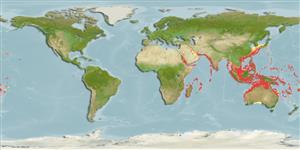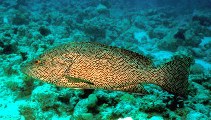Epinephelus chlorostigma (Valenciennes, 1828)
Brownspotted grouper
Waarneming toevoegen in Fish Watcher
| Native range | All suitable habitat | Point map | Year 2050 |

|
| This map was computer-generated and has not yet been reviewed. |
| Epinephelus chlorostigma AquaMaps Data sources: GBIF OBIS |
Saudi Arabia country information
Common names:
Hamoor, Kushar, لُؤز حُبَيْش
Occurrence: native
Salinity: marine
Abundance: | Ref:
Importance: | Ref:
Aquaculture: | Ref:
Regulations: | Ref:
Uses: no uses
Comments: Also Ref. 4787. Data taken, specimen not retained.
National Checklist:
Country Information: https://www.cia.gov/library/publications/resources/the-world-factbook/geos/sa.html
National Fisheries Authority:
Occurrences: Occurrences Point map
Main Ref: Heemstra, P.C. and J.E. Randall, 1993
National Database:
Occurrence: native
Salinity: marine
Abundance: | Ref:
Importance: | Ref:
Aquaculture: | Ref:
Regulations: | Ref:
Uses: no uses
Comments: Also Ref. 4787. Data taken, specimen not retained.
National Checklist:
Country Information: https://www.cia.gov/library/publications/resources/the-world-factbook/geos/sa.html
National Fisheries Authority:
Occurrences: Occurrences Point map
Main Ref: Heemstra, P.C. and J.E. Randall, 1993
National Database:
Common names from other countries
Classificatie / Names Lokale namen | Synoniemen | Catalog of Fishes(Genus, Soort(en)) | ITIS | CoL | WoRMS | Cloffa
> Perciformes/Serranoidei (Groupers) > Epinephelidae (Groupers)
Etymology: Epinephelus: Greek, epinephelos = cloudy (Ref. 45335).
More on author: Valenciennes.
Etymology: Epinephelus: Greek, epinephelos = cloudy (Ref. 45335).
More on author: Valenciennes.
Issue
Common names may have to be split accordingly to former synonym japonicus and new species insularis), following distribution (Ref. 123820).
Environment: milieu / climate zone / depth range / distribution range Ecologie
marien rifbewoner; standvastig; diepte 4 - 300 m (Ref. 11888). Tropical; 37°N - 34°S, 28°E - 169°W (Ref. 5222)
Verspreiding Landen | FAO regio's | Ecosystemen | Voorkomen | Point map | Introducties | Faunafri
Western Indian Ocean: restricted.
Lengte bij maturiteit / Grootte / Gewicht / Leeftijd
Maturity: Lm 27.0, range 23 - 31 cm
Max length : 80.0 cm TL mannelijk / geslacht onbekend; (Ref. 89707); common length : 50.0 cm TL mannelijk / geslacht onbekend; (Ref. 5450); max. gepubliceerd gewicht: 7.0 kg (Ref. 4787); max. gerapporteerde leeftijd: 29 Jaren (Ref. 42001)
Max length : 80.0 cm TL mannelijk / geslacht onbekend; (Ref. 89707); common length : 50.0 cm TL mannelijk / geslacht onbekend; (Ref. 5450); max. gepubliceerd gewicht: 7.0 kg (Ref. 4787); max. gerapporteerde leeftijd: 29 Jaren (Ref. 42001)
Korte beschrijving Determinatiesleutels | Morfologie | Morfometrie
Dorsale stekels (totaal) : 11; Dorsale zachte stralen (totaal) : 16 - 18; Anale stekels: 3; Anale zachte stralen: 8. Live color whitish, with small dark brown spots on head, body, and fins except ventrally on head, thorax, and lower abdomen. Can assume a transient color phase of 3-4 rows of very large round dark spots on top of the small-spot pattern. 96-125 scales in longitudinal series. Pyloric caeca 26-52 (Ref. 04787); characterized further by having ctenoid body scales, except cycloid scales on nape, thorax, parts of ventral abdomen; body with auxiliary scales; greatest depth of body 2.8-3.3 in SL; truncate to slightly emarginate caudal fin; pelvic fins 1.7-2.4 in head length (Ref. 90102); interorbital slightly convex; preopercle angle rounded, 4-7 enlarged serrae at angle below a slight notch; upper edge of operculum straight; posterior nostril not noticeably larger than anterior nostril; maxilla reaches about to vertical at rear edge of eye; scaly maxilla, low step on posterior part of ventral edge; 2-4 rows of teeth in midlateral part of lower jaw, inner ones about twice the size of outer teeth (Ref. 089707).
Found over a wide range of habitats like seagrass beds and outer reef slopes (Ref. 5213), also on mud bottoms. Solitary (Ref. 90102). Feed on small fishes and crustaceans (mainly stomatopods and crabs). Sexual transition from female to male occurs between 35-45 cm, but not all females change sex. Mature individuals form spawning aggregations (Ref. 55367). E. chlorostigma is closely related and very similar to E. polylepis and E. gabriellae which seem to replace it in the northwestern Indian Ocean. Solitary (Ref. 90102).
Levenscyclus en paargedrag Maturiteit | Voortplanting | Paaien | Eieren | Fecunditeit | Larven
Sex change occurs at length of 46.4 cm TL and 3 years of age (Ref. 55367). Also Ref. 6976.
Hoofdreferentie
Upload your references | Referenties | Coördinator | Medewerkers
Heemstra, P.C. and J.E. Randall, 1993. FAO Species Catalogue. Vol. 16. Groupers of the world (family Serranidae, subfamily Epinephelinae). An annotated and illustrated catalogue of the grouper, rockcod, hind, coral grouper and lyretail species known to date. Rome: FAO. FAO Fish. Synop. 125(16):382 p. (Ref. 5222)
Status op de Rode Lijst van het IUCN (Ref. 130435: Version 2024-1)
Niet bedreigd (LC) ; Date assessed: 11 July 2023
Gevaar voor de mens
Harmless
Gebruik door de mens
Visserij: commercieel
FAO(visserij: productie; publication : search) | FishSource | Sea Around Us
Meer informatie
Population dynamics
Groeiparameters
Max. ages / sizes
Length-weight rel.
Length-length rel.
Lengtefrequenties
Massaconversie
Rekrutering
Abundantie
Groeiparameters
Max. ages / sizes
Length-weight rel.
Length-length rel.
Lengtefrequenties
Massaconversie
Rekrutering
Abundantie
Life cycle
Voortplanting
Maturiteit
Fecunditeit
Paaien
Spawning aggregations
Eieren
Ontwikkeling van de eieren
Larven
Larvale populatiedynamiek
Voortplanting
Maturiteit
Fecunditeit
Paaien
Spawning aggregations
Eieren
Ontwikkeling van de eieren
Larven
Larvale populatiedynamiek
Physiology
Body composition
Nutrients
Zuurstofverbruik
Zwemtype
Zwemsnelheid
Visual pigments
Fish sound
Diseases & Parasites
Toxicity (LC50s)
Body composition
Nutrients
Zuurstofverbruik
Zwemtype
Zwemsnelheid
Visual pigments
Fish sound
Diseases & Parasites
Toxicity (LC50s)
Genetics
Genetica
Heterozygosity
Erfelijkheid
Genetica
Heterozygosity
Erfelijkheid
Human related
Aquaculture systems
Aquacultuurprofielen
Kweeklijnen
Ciguatera cases
Stamps, coins, misc.
Aquaculture systems
Aquacultuurprofielen
Kweeklijnen
Ciguatera cases
Stamps, coins, misc.
Tools
Bio-Quiz | E-boek | Veldgids | Determinatiesleutels | Lengtefrequentie Tool | Levenscyclus tool | Verspreidingskaart | Classification Tree
| Catch-MSY |
Speciale rapporten
Bekijk gegevens voor het houden in een aquarium | Bekijk Fact Sheets voor de soort | Bekijk Aquacultuur Fact Sheets
Download XML
Internetbronnen
Aquatic Commons | BHL | Cloffa | BOLDSystems | Websites from users | Bekijk FishWatcher | CISTI | Catalog of Fishes(Genus, Soort(en)) | DiscoverLife | ECOTOX | Faunafri | Fishtrace | GenBank(genoom, nucleotide) | GloBI | GOBASE | | Google Books | Google Scholar | Google | IGFA World Record | MitoFish | Nationale databanken | Otolith Atlas of Taiwan Fishes | PubMed | Reef Life Survey | Scirus | SeaLifeBase | Tree of Life | Wikipedia(ga naar, zoek) | World Records Freshwater Fishing | Zoological Record
Estimates based on models
Preferred temperature (Ref. 115969): 19.1 - 28.2, mean 25.8 (based on 1091 cells).
Fylogenetische diversiteitsindex (Ref. 82804): PD50 = 0.5000 [Uniqueness, from 0.5 = low to 2.0 = high].
Bayesian length-weight: a=0.01047 (0.00646 - 0.01697), b=3.03 (2.90 - 3.16), in cm Total Length, based on LWR estimates for this species & Genus-body shape (Ref. 93245).
Trofisch niveau (Ref. 69278): 4.0 ±0.67 se; based on food items.
Weerstandsvermogen (Ref. 120179): laag, minimale populatieverdubbelingstijd 4,5-14 jaar (K=0.17-0.19; tmax=29; tm=2-3; Fec = 1,014,818).
Fishing Vulnerability (Ref. 59153): Moderate to high vulnerability (51 of 100).
Climate Vulnerability (Ref. 125649): High to very high vulnerability (73 of 100).




